
Sunflowers have been the subject of many pieces of art – be it paintings, music, or film. Know the real deal behind these flowers through these sunflower facts.
- The sunflower’s scientific name is Helianthus.
- Sunflowers are native to North and Central America.
- Sunflowers have 70 different species.
- In general, sunflowers grow from six to ten feet tall.
- Sunflower came from the Greek word “Helios” (Sun) and “Anthos” (Flower).
- The flowers of the sunflower turn towards the sun. Thus, it’s called a sunflower.
- Aside from the fact that its flower turns towards the sun, its flower heads, in combination with its ligules, resemble the sun’s appearance.
- The whorled sunflower in northwest Georgia is the only sunflower with whorled leaves, leafy stems, and yellow disk flowers.
- The Whorled Sunflower is on the list of endangered species.
- Industrial forestry and pine plantations are the major threats for the sunflowers.
- The Native American communities grew sunflowers as a crop as far as Mexico to Southern Canada.
- Sunflowers uses a method called “cross-pollination” for its reproduction.
- Cross-pollination attracts insects such as bees. As a result, it spreads the reproductive pollen from one flower to another.
- Even without the cross-pollination, a sunflower can self-reproduce by turning itself around its powder.
- Sunflowers require more than 6 to 8 hours of sunlight every day to stay healthy.
- In contrast to popular belief, not all sunflowers grow with the same size and color.
- The sunflower seeds are a nutrient-dense food.
- Sunflower seeds are excellent sources of fiber and antioxidants.
- A hundred grams serving of sunflower seeds contains 21 grams of protein.
- Naturally, the sunflower seeds are cholesterol-free, gluten-free, and low in saturated fat.
Sunflower Facts Infographics
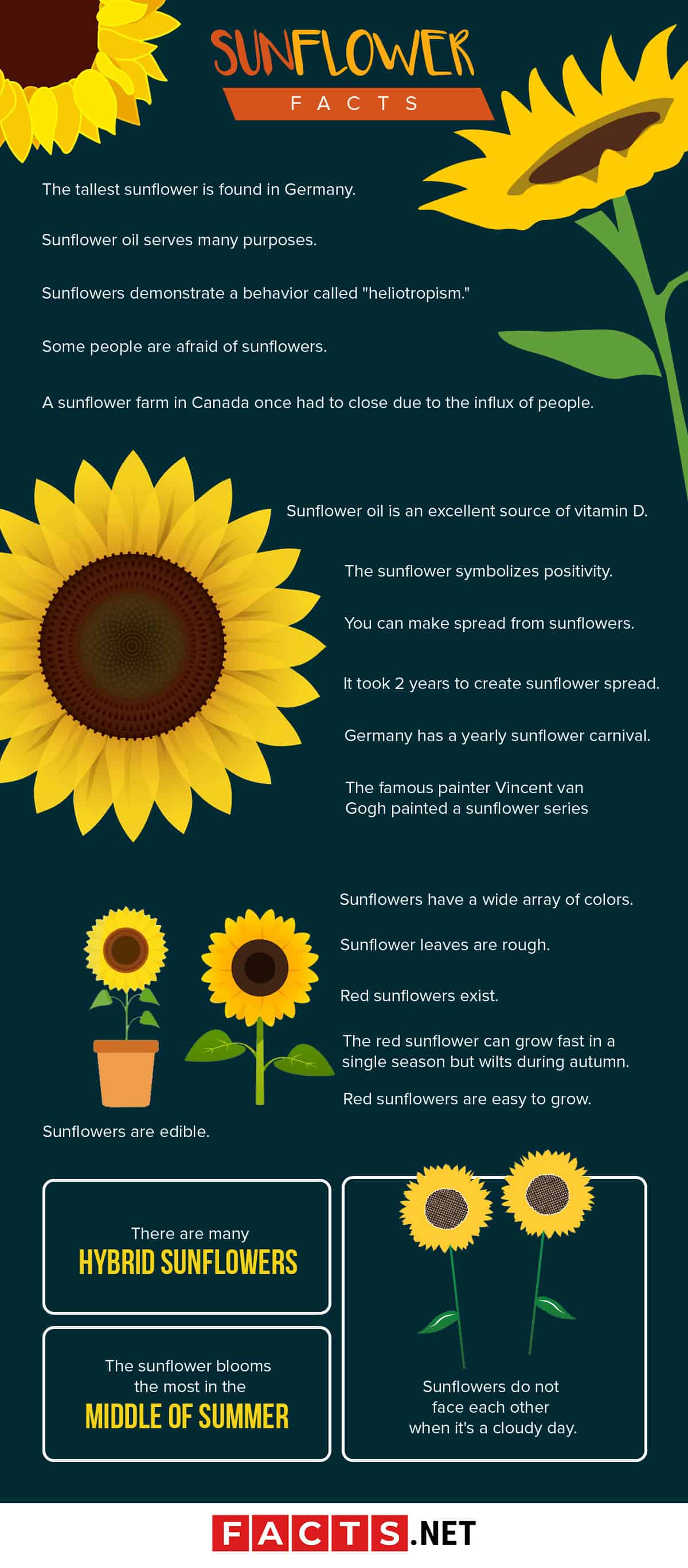
The tallest sunflower is found in Germany.
When Hans-Peter Schiffer grew a 30-foot suflower in Germany, he had already broken his personal best a second time. Schiffer’s sunflowers broke three consecutive Guinness World Records for the tallest sunflower of all time.
Sunflower oil serves many purposes.
Alternatively, aside from being a vitamin, the sunflower oil can also be a substitute for the regular cooking oil. Sunflower oil is also a great leather conditioner, as well as a hair conditioner.
Sunflowers demonstrate a behavior called "heliotropism."
One of the sunflower’s most unique traits is a phenomenon called “heliotropism”. Sunflowers are responsive to the direction of the sun. Sunflower buds face east in the morning and follow the sun as the earth moves throughout the day.
Some people are afraid of sunflowers.
Although sunflowers are a symbol of positivity, some people are scared or have irrational fear against it. Being afraid of the sunflower is called Helianthophobia. It can sound weird to some people who admire the beauty of sunflowers, but the key reasons are its look, smell, or even just its thought.
A sunflower farm in Canada once had to close due to the influx of people.
Bogle Seeds is a family-owned sunflower plantation in Toronto, Canada. The 28-hectare farm had to close temporarily due to overcrowding from its visitors that are taking selfies in July 2018. Even more, police had to get involved in managing the traffic, as they estimated that more than 7,000 vehicles wanted to enter Bogle Seeds at the same time.
Sunflower oil is an excellent source of vitamin D.
Some people don’t get enough sunlight that they need due to the nature of their work or environment. Sunflower oil is an excellent source of vitamin D, as well as vitamin A, E, phosphorus, magnesium, selenium, copper, and iron. Taking sunflower oil as a food supplement can help with deficiency.
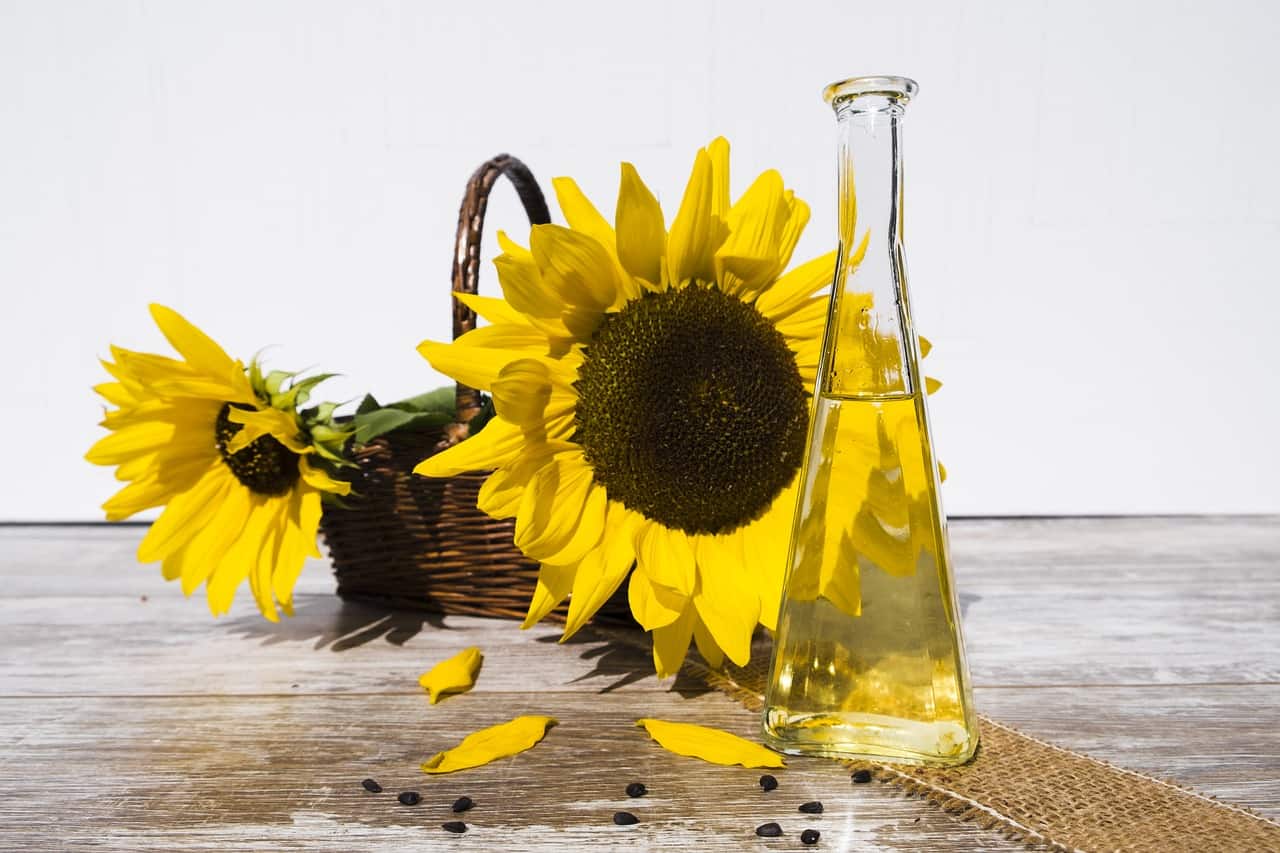
The sunflower symbolizes positivity.
Flowers have inspired humans throughout history and fascinated their consciousness in many ways. Because of this, the sunflower traditionally symbolizes life, joy, loyalty, as well as longevity.
You can make spread from sunflowers.
SunButter is a peanut butter alternative made of sunflower seeds. One of the biggest manufacturers of SunButter is SunGold Foods, Inc. from Fargo, North Dakota, United States.
It took 2 years to create sunflower spread.
In the year 2000, the Agricultural Research Service of the United States (an in-house research agency) started a two-year project to create a substitute for peanut butter, which will be using sunflower seeds as its base. In 2002, SunButter was born. Now, the country also distributes energy bars and premade SunButter sandwiches. How’s that for sunflower facts?
Germany has a yearly sunflower carnival.
One of the more interesting sunflower facts: Every year in Cologne, Germany, its locals, as well as the tourists, celebrate the Cologne Carnival. During the event on May 14, 2015, more than 700 members of the Cologne Carnival Society wear sunflower costumes/outfits, making it the biggest gathering of people to have dressed as sunflowers.
The famous painter Vincent van Gogh painted a sunflower series.
The famous painter Vincent van Gogh was a Dutch post-impressionist who is among the most influential figures in the history of Western art. He created two series of still life paintings of sunflowers. The first series, executed in Paris in 1887, depicts the flowers lying on the ground. The second series, made a year later in Arles, France, displays a bouquet of sunflowers in a vase.
Sunflowers are edible.
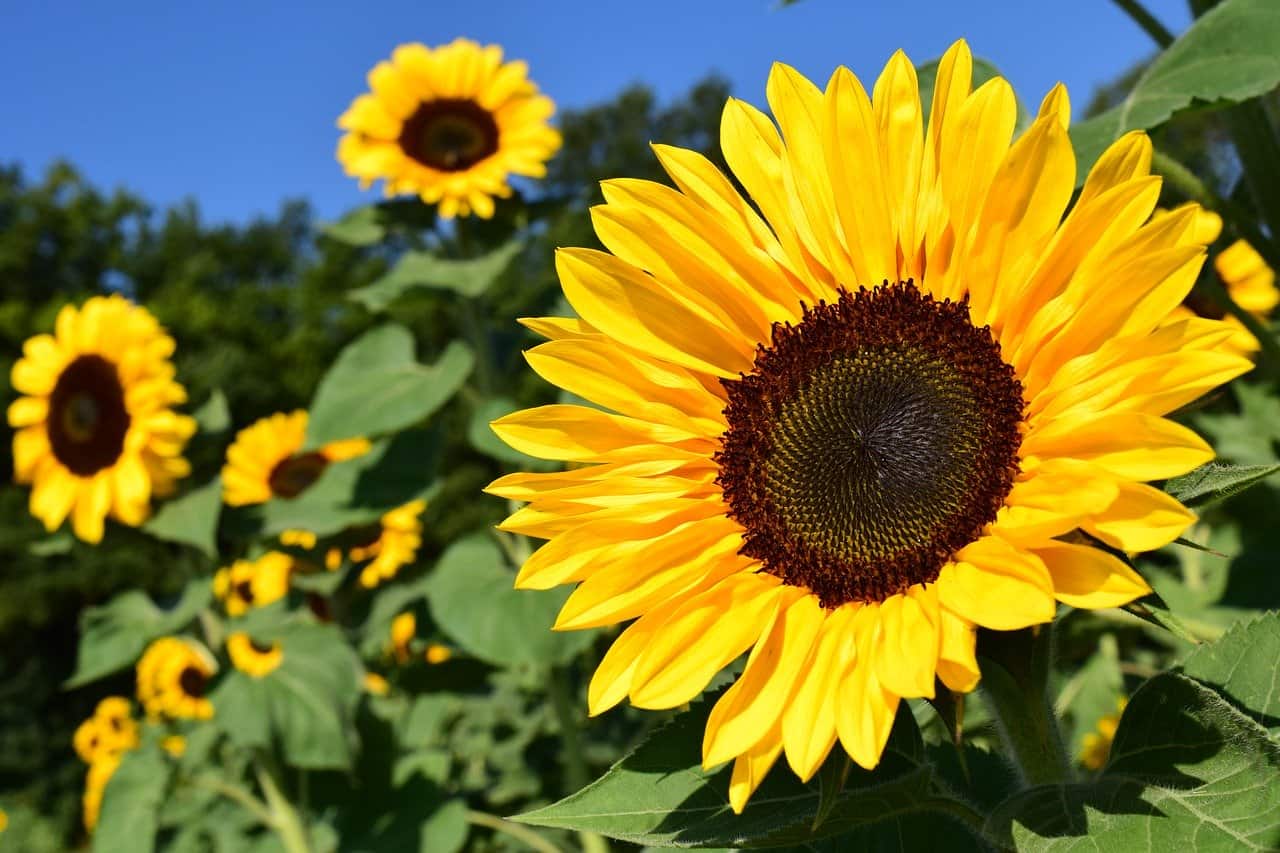
Sunflowers are completely safe to eat from its roots to the petals. Although they do not offer the best flowery flavors out there, its bitter taste adds a twist to the flavor and boosts the color in raw dishes like salads.
Sunflowers have a wide array of colors.
The most common sunflower colors are bright yellow with brown centers. However, other varieties exhibit other shades of bright yellow, copper, red, brown, orange, and bi-colored.
Sunflower leaves are rough.
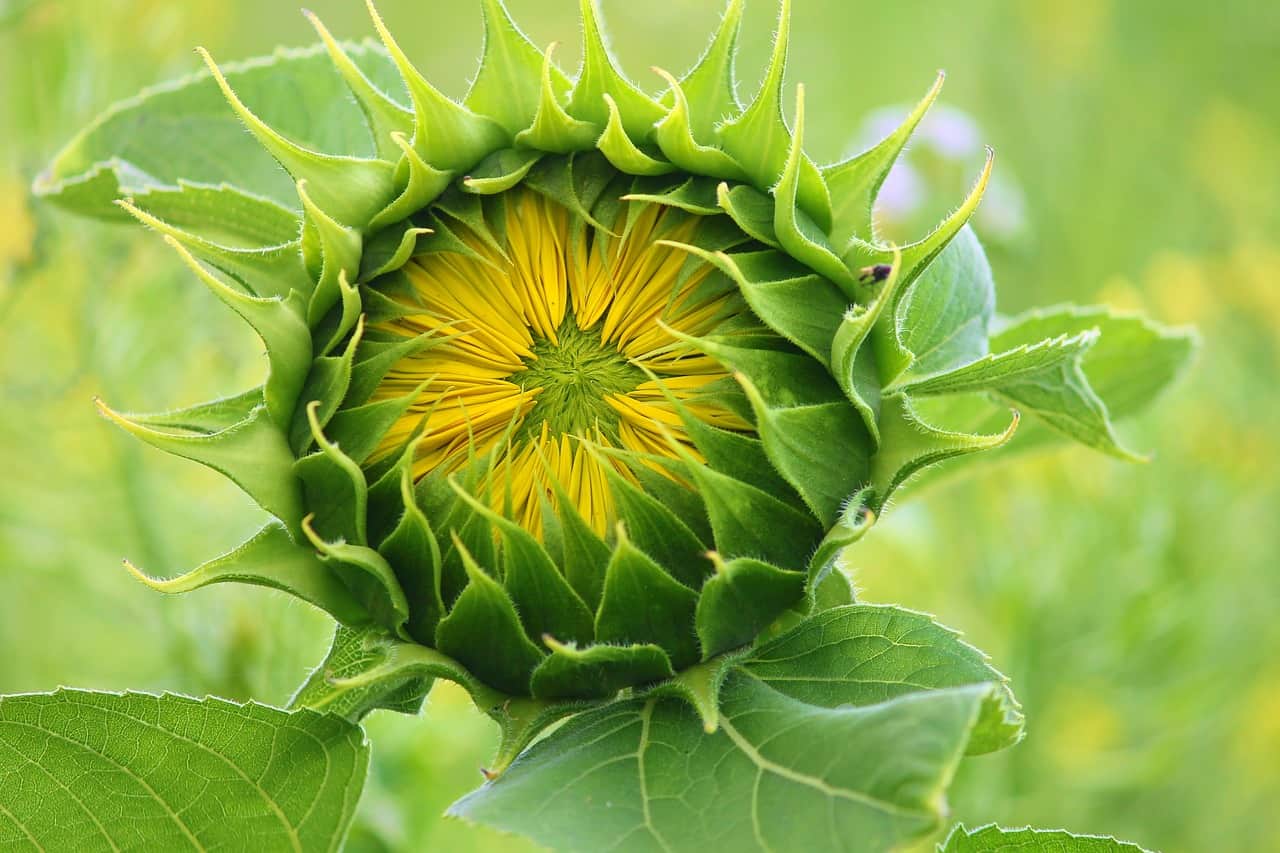
Sunflower leaves appear spiky and oval, measuring 30cm long with a rough, hairy surface. Furthermore, the upper surface of the leaf is dull green with light green petioles that are also covered with short hairs.
Red sunflowers exist.
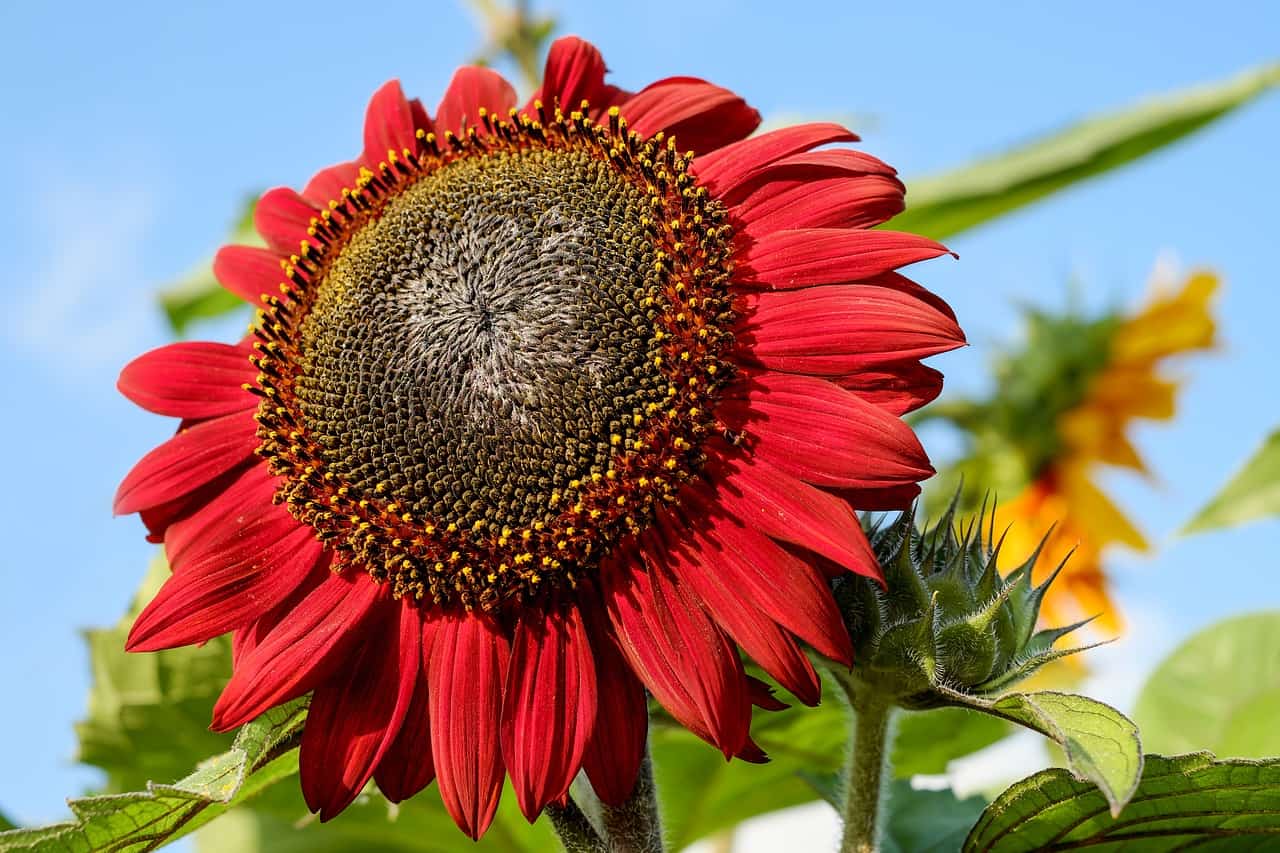
Characterized by vibrant red petals and a dark brown center, the red sunflower grows up to 6 ft tall with 5″-6″ blooms. Each plant rears 5 beautiful flowers.
The red sunflower can grow fast in a single season but wilts during autumn.
The red sunflower is an annual flowering plant. It grows fast from the fresh harvest seeds. The plant produces stems, leaves and then flowers, all within a single growing season. However, upon the arrival of late autumn, the red sunflowers will begin to wilt. Gathering the seeds from the plants before autumn is the best way to regrow them in the following year.
Red sunflowers are easy to grow.
The red sunflowers are one of the easiest plants to grow coming from fresh flower seeds. The red sunflowers only need little attention and they are not particular to soil conditions. This variety is perfect for bouquets and floral arrangements.
There are many hybrid sunflowers.
Hybrid sunflowers are one of the top varieties of the plant. The cherry rose sunflower, for instance, is one of the most common hybrid variety that produces pollen-free blooms. Its color is different from the regular sunflower – the center of the flower is maroon while its petal tips are light peach.
The sunflower blooms the most in the middle of summer.
In general, sunflowers start to bloom during the summer season and peaking mid-year. However, late bloomers can follow as late as the fall season to catch up.
Sunflowers do not face each other when it's a cloudy day.
There’s a common myth that sunflowers face each other during cloudy days. Although it may sound like one of the cuter sunflower facts, it’s actually scientifically inaccurate. Sunflowers only respond to the sun, and will stay in place in its absence.
Young or immature sunflowers will track the sun's trail during cloudy days.
In some cloudy days, young or immature sunflowers will still track the sun’s trail even if the sunshine is entirely blocked by the clouds. But as soon as the sunflower matures, it will be “wise enough” to stop following the sun’s direction and be contented with the little rays they receive.
Mature sunflowers face east all day long.
Although the sunflower follows the sun’s direction all day long, there will be a time that it will completely stop its habit. When the sunflower is fully grown, it will stop following the sun’s trail and simply face east all day long.
Dwarf sunflowers can be grown outdoors and indoors.
Dwarf sunflowers can be placed in a 15-cm container with a soil-based potting mix. Their tiny size is a great match for small pots that can be grown outdoors and even indoors.
Dwarf sunflowers need proper moisture and sunlight.
Although Dwarf Sunflowers can endure a dry environment, it does thrive even better in soil that is lightly misted throughout the day and night. Ensuring that the soil of the dwarf sunflowers has an adequate moist, along with at least six hours of direct sunlight a day is the best way to maintain them. Definitely one of the sunflower facts to keep in mind if you want a new hobby.
Perennial sunflowers can last over 2 years.
You may be used to flowers withering in days, but perennial sunflowers can live over two years. It is a cross between wild perennial and domestic annual sunflower species.
The Jerusalem Artichoke Sunflower isn't from Jerusalem.
The Jerusalem artichoke is one of the perennial sunflowers. The name of this sunflower can be misleading since the Jerusalem artichoke is native to central North America. No one knows why the term “Jerusalem artichoke” is used for it. The Jerusalem artichoke is also known as sunroot, sunchoke, and earth apple.
Germination is the first phase of the sunflower's life cycle.
Sunflowers undergo five different stages during its life cycle. It starts with germination. Once the seed is planted, it takes eight days for the roots to mature from the seed. Eventually, a shoot will push through the top of the soil. The germination period typically begins from mid-April to late-May.
The vegetative phase is the second phase of the sunflower's life cycle.
At this time, the sunflower will still be a seedling for as much as 13 days after it shoots through the soil. Once the plant develops its first leaf (at least four centimeters long), the plant is officially in vegetative stage one or V1. As soon as the sunflower grows two leaves with another four centimeters long, it advances to vegetative stage two or V2, and so on. If the sunflower is planted during April or May, the vegetative phase will occur in May or early June.
The reproductive phase is the third phase of the sunflower's life cycle.
When buds of the sunflower forms between the plant’s cluster of leaves, it is the sign of the reproductive phase. The bud can originally have a star-like figure, but once the reproductive phase is done, the bud will transform into the tall stemmed. It would take thirty days for a sunflower to bloom and its reproductive phase will start in June and end in July or August.
The blooming phase is the fourth phase of the sunflower's life cycle.
When the sunflower is in full bloom, it takes approximately 20 days to appreciate the beauty of the flower. The blooming phase gives the chance for bees to pollinate the flower and fertilize the seeds.The seeds will start to ripe at this stage and the back of the sunflower head will turn yellow. This is also the time to enjoy the sunflower’s yellow blooms by decorating them in the flower vase or by creating a bouquet of sunflowers.

The harvesting phase is the fifth and final phase of the sunflower.
During the harvest phase, the sunflower will droop and eventually turn brown. To harvest the flowers, one must cut it four inches from the head store the sunflower head upside down in a breathable dry bag. The seeds should be ready to harvest 110-125 days after you planted the flower.
Sunflowers are annual plants.
When sunflower seeds are planted in May, the sunflower will wilt in early or mid-August. In other words, sunflowers are annual plants, and they need to be replanted each year.
Fresh sunflower decorations can last up to 12 days.
A vase full of sunflowers will enhance the room’s atmosphere through its beauty. The sunflowers in the vase may last anywhere from one week up to 12 days. Taking good care of the sunflowers will extend its life – a well-hydrated sunflower will help support their heavy head weight.
Sunflowers are a good choice for weddings.
For weddings, sunflowers symbolize strength, adoration, and loyalty.
Sunflowers are daisies.
The sunflower belongs to the daisy family (Asteraceae) which has over 1,500 genera and more than 20,000 species. It is the biggest family of flowering plants. Daisies share this family with sunflowers, chrysanthemums, and lettuce.
The sunflower seeds' pattern obeys the Fibonacci sequence.

The sunflower seeds’ pattern obeys the Fibonacci sequence – 1, 2, 3, 5, 8, 13, 21, 34, 55, 89, 144. The seeds in the middle of the sunflower are arranged under this popular Fibonacci sequence.
Sunflowers can help with sadness.
In contrast to helianthophobia (where few people have irrational fear or phobia towards sunflowers), sunflowers are “happy and cheery flowers.” Moreover, upon looking at a sunflower, it provides an instant effect that makes humans feel better.
Russia and Ukraine are the world's largest producer of sunflower oil.
Russia is the largest producer of sunflower oil with over 1.8 million tonnes of products every year. The sunflower agriculture in Russia takes up approximately 6.8 million hectares of land with the growing regions of Rostov, Saratov, Krasnodar, Belgorod, and Voronezh.
Every year, Ukraine's sunflower oil earnings are estimated at $3.7 billion.
As the second-largest producer of sunflower oil, the economy of Ukraine benefits from the total sales which are estimated at $3.7 billion. With more than 1.7 million tonnes of products every year, the main market for Ukraine’s sunflower oil is India, which imported 30%, followed by China with 16%.
There is no other flower that has the name "flower" in its name aside from the sunflower.

Here is the list of other popular flowers:
- Tulip
- Rose
- Cherry blossom
- Orchid
- Chrysanthemum
- Lily
- Lotus
- Water lily
- Dandelion
- Hyacinth
- Daisy
- Crocus
Ukraine's national flower is the sunflower.
The sunflower is the national flower of Ukraine and played a significant role in Ukrainian culture. On most occasions, Ukrainians would fabricate the sunflowers into wreaths for the girls and ladies, embroidered them on clothes, carved them on wooden furniture, and even painted them on walls – showing how much sunflower is important to its culture.
Sunflowers are inside the Ukrainian's traditional art, poetry, and songs.
According to Ukrainian culture, it is believed that sunflowers could be used to repel against evil spirits, bad fortune, and illness. Embedded in national folklore, sunflowers are inside the Ukrainian’s traditional art, poetry, and songs.
Halva is a delicious dessert that is sunflower-based.
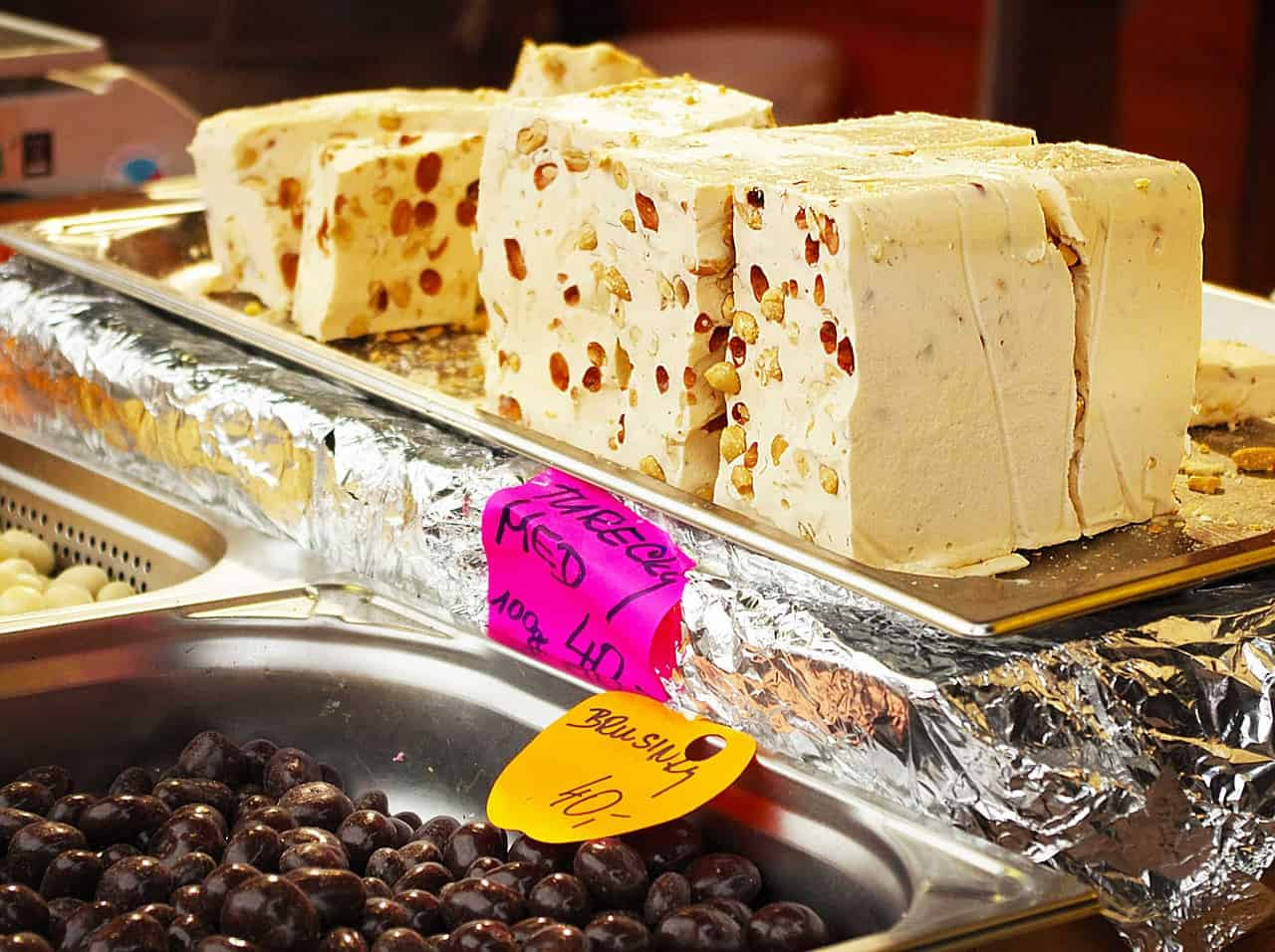
Popular not just in Ukraine but also in other parts of the world, Halva is a delicious dessert that is sunflower based – with the ingredients of:
- 1 1/2 cups hulled sunflower seeds
- 1 tbsp sunflower oil
- 1/3 cups granular sugar
- 1/3 cup honey
- 2 tbsp water
- 1 tsp vanilla extract
- pinch of salt
There are many variations of Halva. While others use sesame seeds instead of sunflower seeds, the sunflower based ingredients are arguably the best tasting of them all.
Sunflower is the state flower of Kansas.
The sunflower grows everywhere in Kansas because of its adaptability to the soils (either sand or clay – no problem) and a strong tolerance of dry to medium moist soils. During the fall season, the sunflowers give the grasslands and roadsides a golden glow.
There are three types of sunflower seeds.
Linoleic seeds are the most common of them all, while the sunflower oil seeds are the second one, and last, but not least is, high oleic. Each of them has their unique levels of monounsaturated, polyunsaturated, and saturated fats.
Sunflower heads consist of up to 2,000 individual flowers.
These tiny individual flowers are joined together by a receptacle base. Its big petals around the edge of the head are individual ray flowers but can’t develop into seeds.
Sunflowers can absorb toxins.
After a devastating tsunami destroyed reactors in Japan’s Fukushima nuclear power plant, millions of sunflowers were planted as a stopgap measure.
The sunflower is medicinal.
A tea that is made from the sunflower leaves is a natural alternative for treating high fevers. The crushed leaves of the sunflower are also used as a medicine for sores, swellings, spider bites, as well as snake bites. Furthermore, a tea that is made from the flowers of the sunflower is good for treating malaria and lung ailments.
Sunflowers have been to outer space.
In the year 2012, a selected number of sunflower seeds traveled to space along with astronaut Don Pettit. The astronaut from NASA brought sunflower on the International Space Station as part of his personal biology experiment.
Sunflowers are made of thousands of tiny flowers.
It may not look like it, but sunflower heads are actually made of thousands of tiny, individual flowers joined together at the base. The yellow petals are individual undeveloped flowers.
Was this page helpful?
Our commitment to delivering trustworthy and engaging content is at the heart of what we do. Each fact on our site is contributed by real users like you, bringing a wealth of diverse insights and information. To ensure the highest standards of accuracy and reliability, our dedicated editors meticulously review each submission. This process guarantees that the facts we share are not only fascinating but also credible. Trust in our commitment to quality and authenticity as you explore and learn with us.


